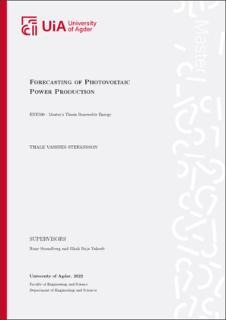| dc.description.abstract | Solar irradiance and temperature are some weather parameters that affect the amount of power photovoltaic cells can generate. Based on these and past power production, future production can be predicted. Knowing" future generation may help the integration of this renewable energy source on an even larger scale than today, as well as optimize the use of them today. In this thesis, forecasting of future power generation was made by an artificial neural network (ANN) model, a support vector regression (SVR) model, an auto-regressive integrated moving average (ARIMA) model, a quantile regression neural network (QRNN) model, an ensemble model of ANN and SVR, an ANN ensemble model and an ANN model using only numerical weather predictions (NWPs) as inputs. Correlation techniques and principal component analysis were used for feature reduction for all models.
The research questions for this thesis are, "How will the models perform using random train data to predict August 2021, compared to a random test sample? Will the ensemble models perform better than the standalone models, and will the quantile regression neural network make accurate prediction intervals? How well will the predictions be if the ANN model only uses NWP data as inputs, compared to both historical power and NWPs?". As well as to answer these questions, the objective of this thesis is to provide a model or multiple models that can accurately predict future power production for the PV power system in Lillesand.
All models can predict future power production, but some with less accuracy than others. Of all models, as expected, both ensemble models performed best overall for both tests. The SVR model did however perform with the lowest MAE for the August test. For different fits, these results will probably slightly change, but it is expected that the ensemble models will still perform best overall. | |
